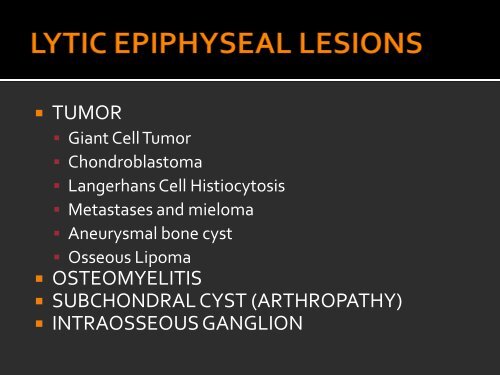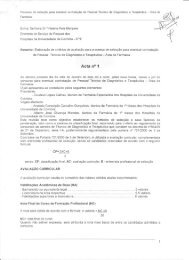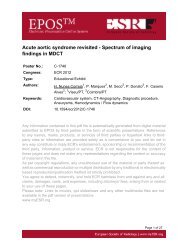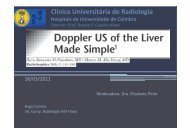LYTIC EPIPHYSEAL LESIONS - H.U.C.
LYTIC EPIPHYSEAL LESIONS - H.U.C.
LYTIC EPIPHYSEAL LESIONS - H.U.C.
- No tags were found...
Create successful ePaper yourself
Turn your PDF publications into a flip-book with our unique Google optimized e-Paper software.
• TUMOR• Giant Cell Tumor• Chondroblastoma• Langerhans Cell Histiocytosis• Metastases and mieloma• Aneurysmal bone cyst• Osseous Lipoma• OSTEOMYELITIS• SUBCHONDRAL CYST (ARTHROPATHY)• INTRAOSSEOUS GANGLION
• Most common sites: About the knee, distalradius and spine (sacrum or body of vertebra)• Approximately 10% local recurrence rate, butcan be higher with less agressive surgery.• Recurrent tumors behave more aggressively.
• Helms uses four radiographic criteria fordiagnosing GCT (“95% effective”):• GCT occurs only in patients with closed epiphyses• The lesion must be epiphyseal and abut the articularsurface• GCT tumors are said to be eccentrically located in thebone• The lesion must have a sharply defined zone oftransition that is not sclerotic• Once one of the criteria is violated, theremainder don’t even have to be used toeliminate a GCT!
• MRI• Uniform, intermediate-low signal intensity on T1• Enhance with intravenous gadolinium• Often relatively low T2 signal in nodular, zonal,whorled or uniform pattern – can help distinguishGCT from other common subchondral lesionssuch as subchondral cyst or a Brodie’s abscess,which are usually uniformly bright• Fluid-fluid levels also may be seen
GIANT CELL TUMOR – CASE 1 – Woman, 53 yearsX-ray and CT – Well-defined lytic lesion in the distal radius that has all four criteria typicalfor a giant cell tumor: (1) a well-defined but nonsclerotic zone of transition, (2) epiphysesare closed, (3) the lesion is eccentrically placed in the bone and (4) the lesion is epiphysealand abuts the articular surface. CT shows cortical rupture (not seen at x-ray).
GIANT CELL TUMOR – CASE 1 – Woman, 53 yearsT1T1T2MRI – The lesion has intermedius sign on T1. On T2 it is heterogeneous, withpredominantly high signal, with some areas of low signal. There is no osseousedema neither soft tissue mass.
GIANT CELL TUMOR – CASE 2 – Man, 38 yearsX-Ray – Large lytic lesion in the distal femoral epiphysis, extending to thesubchondral bone. There is no matrix and the zone of transition is narrow andlacks a sclerotic margin. This is a typical appearance and location of CGT.
GIANT CELL TUMOR – CASE 2 – Man, 38 yearsT1T2MRI – The lesion has low signal on T1 and also low signal on T2 (althoughheterogeneous) in relation with abundant hemosiderin deposition. There is corticalrupture but no soft tissue mass.
GIANT CELL TUMOR – CASE 3 – Man, 70 yearsX-Ray and CT – Lytic lesion of the proximal tibia (epiphysis and metaphysis). This patient is 70years old, so metastase must be in differential diagnosis. However there was no known primarytumor and histology demonstrated GCT.
GIANT CELL TUMOR – CASE 3 – Man, 70 yearsT1MRI – The lesion is heterogeneous with low signal on T1 and high signal on T2. There is corticalthining and rupture, perilesional edema and a small soft tissue mass anteriorly.T2
GIANT CELL TUMOR – CASE 4 – Man, 30 yearsX-Ray and CT – Eccentric (lateral side), subarticular lytic lesion, of the distal epiphysis (andmetaphysis) of tibia. This is another typical GCT that fills the four Helms’ criteria.
GIANT CELL TUMOR – CASE 4 – Man, 30 yearsT1 after GadoliniumT1T2MRI – The lesion has low signal on T1 and high signal on T2. There is cortical thinning, bonemarrow and soft tissue edema and articular effusion, but no soft tissue mass. After gadoliniumthere is relatively homogeneous enhancement.
• Uncommon benign neoplasm that occurs almostexclusively in the epiphysis in immature skeleton(< 30 years old)• Proximal humerus and around the knee are themost common locations• The lesion tipically has geographic and scleroticmargins• The tumor is predominately lytic, althoughchondroid matrix is present in 50% of cases• May elicit prominent periosteal reaction in themetaphysis (remote from the lesion)
• MRI• Isointense with muscle on T1• Intermediate heterogeneous to high signalintensity on T2• Often in a lobulated pattern• Intense bone marrow and adjacent soft tissueedema, suggesting a more aggressive lesion thanis demonstrated by radiography
CHONDROBLASTOMA – CASE 1 – Man, 18 yearsX-Ray – AP radiograph of the Knee is normal. However lateral radiograph shows a verysubtle geographic lytic lesion in the posterior epiphysis (circle).
CHONDROBLASTOMA – CASE 1 – Man, 18 yearsMRI – Here we can see that the lesion is located in medial condyle (postero-superior position) of the distal epiphysisof femur. The lesion has lobulated margins and is isointense with muscle on T1 and on T2 it is heterogeneous withareas of high signal. There is marked peritumoral edema. The findings are typical for chondroblastoma.
CHONDROBLASTOMA – CASE 2 – Man, 19 yearsX-Ray - Central, lytic lesion located at the proximal epiphysis (and metaphysis) of tibia. The lesion hasgeographic and sclerotic margins (black arrows). Note the very dense, mature periosteal reaction inthe metaphysis (orange arrows), remote from the tumor. Radiological findings and the age of patientare very typical for chondroblastoma.
CHONDROBLASTOMA – CASE 2 – Man, 19 yearsT1T2T2*MRI – The lesion is located in the epyphisis in a central and posterior position. Is has intermedius signon T1 with a lobular pattern, on T2 it is predominantly low signal, containing some small areas of highsignal. There is edema of the muscles in contact with the tumor and periosteal reaction in posteriormetaphysis. MRI appearance is also suggestive of chondroblastoma. Remember, giant cell tumorusually is eccentric and the margin is not sclerotic.
• Rare spectrum of disorders related to histiocyticinfiltration of various organ systems• Letterer-Siwe disease: Agressive multi-organsystem disease, age 0-2 years, high mortalityrate.• Hand-Schüller-Christian disease: Intermediate,chronic multi-organ system disease• Eosinophilic granuloma of bone: Single organsystem involvement in bone
• Bone lesions may have a variety of appearances:it can be blastic or lytic, well or ill defined, haveor not have a sclerotic border, may or may notelicit a periosteal response, with or without asoft tissue mass, with or without bonesequestrum…• One classic pattern of long bone lesions beginswith a highly agressive moth-eaten orpermeative pattern and soft tissue mass, butusually heal spontaneously over 6-24 months.The margin becomes well defined and periostealreaction becomes solid.
• These lesion are usually central andmetadiaphyseal, but any part of the bone(including epiphysis) may be involved• Difficult to exclude LCH from almost anydifferential of a bony lesion• Patients must be younger than 30 years• 10 – 20 % polyostotic• Spine: Vertebra plana• Skull: Beveled edge sharply defined lyticlesion
EOSINOPHILIC GRANULOMA – Man, 21 yearsX-Ray and CT - This small lesion is difficult to detect and describe in the radiographic studieswhereas in CT it’s easier to identify the small lytic focus in the posterior surface of the left lateralfemural condyle.
• More common than primary bone tumors• 80% arise from primary tumors of the lung,breast, prostate and kidney• Usually have a moth-eaten or geographicpattern with an ill-defined or wide zone oftransition, no sclerotic margin and often littleperiosteal reaction or soft tissue mass• Occasionally may present as a geographic,bubbly, expansile mass• The density of metastases varies: can be purelylytic, blastic or mixed lytic and blastic
• Most metastases occur where bone marrow isfound – 80% are located in the axial skeleton andproximal humerus and femur• Epiphyseal involvement, although not frequent,can occur• The diagnosis is straightforward if numerouslesions are noted• Helms says that metastatic disease should beconsidered for any lytic lesion – benign oraggressive in appearance – in a patient olderthan 40 years
OSSEOUS METASTASIS – CASE 1 - Man, 63 yearsX-Ray and MRI – Radiolucent lesion in distal femur that extends to articular surface. Although radiographic appearanceis compatible with an agressive (there is cortical rupture ande soft tissue mass) giant cell tumor, advanced age ofpatient and history of renal cell carcinoma argues otherwise. Results of pathologic examination confirmed solitaryepiphyseal metastasis from a primary kidney tumor.T1
OSSEOUS METASTASIS – CASE 2 - Woman, 61 yearsX-Ray – This patient with lung carcinoma had morphologic and strutural changes of left head and neckof femur, with multiple and confluent faintly seen lytic lesions. This was suspicious for osseousmetastasis.
OSSEOUS METASTASIS – CASE 2 - Woman, 61 yearsCT confirms that there are multiple andconfluent lytic lesions of femural head andneck. The diagnosis of metastases isstraightforward if numerous lesions are notedthroughout the skeleton and the patient has aprimary tumor like this case.
OSSEOUS METASTASIS – CASE 2 - Woman, 61 yearsT1T2MRI – The lesion is heterogeneous, with lowsignal on T1 and high signal on T2.T1
OSSEOUS METASTASIS – CASE 3 - Man, 71 yearsX-Ray and CT – This is another patient with metastasis of renal cell carcinoma located inmetaphysis and epiphysis of left humerus. Typically an expansile lytic metastasis should be eitherrenal (like this case) or thyroid in origin.
OSSEOUS METASTASIS – CASE 3 - Man, 71 yearsCT - This patient had other metastasisthroughout the body: sacrum (the largestone), right femural head, ribs and spine(not shown).
• Most common appearance: Multiple punchedoutlytic lesions with a narrow zone of transition• May present as diffuse osteopenia, without focallytic lesion• Occasionally presents as a focal lytic expansilelesion – plasmacytoma – usually have a relativelynarrow zone of transition, without scleroticmargins and no matrix calcification• Bone scanning and skeletal radiographic surveyare complementary studies, as each misses alarge number of myeloma lesions
• The most common sites of occurrence reflectthe distribution of red marrow in the skeleton– skull, vertebral bodies, pelvis, femur andhumerus• Like metastasis, generally myeloma shouldbe considered only in a patient older than 40years
MULTIPLE MYELOMA – CASE 1 - Man, 66 yearsX-Ray – A diffuse moth-eatenpattern is seen throughout thediaphysis, metaphysis andepiphysis of the femur, which ischaracteristic for myeloma. Inthe upper third of diaphysisthere is a central well definedlytic lesion (arrow).
MULTIPLE MYELOMA – CASE 1 - Man, 66 yearsMRI – Multiple nodules throughout the femur, with low signal on T1 and high signal on T2.
MULTIPLE MYELOMA – CASE 2 - Woman, 46 yearsCT and X-Ray - Multiple punched-out lytic lesions with a narrow zone of transition – skull, vertebralbodies and pelvis. These are the most common sites of ocurrence and reflect the distribution of redmarrow in the skeleton.
PLASMACYTOMA – CASE 3 - Woman, 53 yearsCT - Focal lytic expansil lesion of humerus’ epiphysis.There is evidente cortical rupture (circle), but noperiosteal reaction and no associated soft tissue mass.There were no lesions in the remaining skeleton andbiopsy showed plasmacytoma. Remember, in patientswith > 40 years, we cannot exclude metastases andmultiple myeloma/plasmacytoma from the differentialdiagnosis of a lytic epiphyseal lesion.
• Expansile (often extremely), lytic, narrowzone of transition, eccentric, no tumor matrix• Thin, intact shell of expanded overlying bone.• Generally under 30 years of age• CT and MRI demonstrate fluid-fluid levels inmost cases• Occasionally it is rapidly progressive,simulating a more agressive lesion
• May be post-traumatic (often corticallybased) or secondary within a pre-existingtumor – look for a solid enhancingcomponent that might represent the primarytumor• Monostotic and usually occurs in themetaphyses or metadiaphysis of long bones• Occasionally can occur in the epiphyses, butthere is no location in which they should begiven more weight in the differential
SECONDARY ANEURYSMAL BONE CYST - CASE 1 – Woman 22 yearsX-Ray – Slightly expansil lytic lesion of metaphysis and epyphisis of right humerus. At first glanceone might consider this typical for a giant cell tumor. However, note the sclerotic margins, that thelesion does not abut the articular surface and it is eccentric.
SECONDARY ANEURYSMAL BONE CYST - CASE 1 – Woman 22 yearsCT confirms that there is some cortical thinning, butno cortical rupture, no tumoral matrix calcificationand no associated soft tissue masses.
SECONDARY ANEURYSMAL BONE CYST - CASE 1 – Woman 22 yearsT1T1T1 after gadT2T2T1 after gad
ANEURYSMAL BONE CYST - CASE 2 – Man 16 yearsX-Ray and CT – This case is not a epiphyseal lesion. However this exampledemonstrates the typical appearance of aneurysmal bone cyst: an eccentriclocated metaphyseal and very expansil lesion; this is a large butnonaggresive lesion (no cortical rupture and no soft tissue mass associated).
ANEURYSMAL BONE CYST - CASE 2 – Man 16 yearsT1T2T2MRI shows the typical bone expansion and multiple fluid levels (T2).
ANEURYSMAL BONE CYST - CASE 3 – Man 20 yearsX – Ray – Very expansil (“aneurysmal”) lytic lesionof epiphysis and metaphysis of fibula. Repair inthe thin, intact shell of expanded overlying bone,typical of aneurysmal bone cyst.
• Rare fatty lesion of bone• Lytic lesion with a geographic scleroticmargin and no matrix or host reaction• Fat density on CT and fat signal intensity onMRI and may be distinguished by having acentral nidus of dystrophic calcification• Most often found in the metaphyses of longbones and the calcaneus, but can occuranywhere including epiphysis
OSSEOUS LIPOMA - Man, 45 yearsX-Ray – “Multiloculated” lytic lesion located at lateral condyle of righ femur. The margin of thelesion is geographic and sclerotic. There is no periosteal reaction neither soft tissue mass.
OSSEOUS LIPOMA - Man, 45 yearsCT - The lesion is located at distal epiphysis of femur (predominantly lateral condyle); it haslobulated and sclerotic margins and it is of homogeneous fatty attenuation.
OSSEOUS LIPOMA - Man, 45 yearsT1 T1 FS T 1T2MRI - The tumor shows fat signal intensity on all sequences.Repair that the lesion looses signal intensity on T1 with fatsaturation (FS). This is a somewhat atypical case becauselipomas are most often found in metaphysis.
• The radiologic spectrum of osteomyelitis isvery large• Periosteal reaction: without; linear periostealreaction; thick periosteal reaction; laminated(“onion peel”); Codman’s triangle;…• Bone destruction: Permeating bone lesion;Punched out bone; Moth-eaten; Geographic(Brodie’s abscess); Agressive osteolysis; Welldefinedosteolytic lesion with thick scleroticborder;…
• Sequestrum: Fragment of infected necroticbone. Potencial source of chronic infection.• Involucrum: New bone formed aroundsequestrum• Sinus tract: Soft tissue channel between boneand skin. Pus drains through it.• Cloaca: Cortical and periosteal defect. Pus drainsthrough it.• Abscess: Pus-filled cavity lined with granulationtissue.• MRI for abscess, sinus tract, cloaca, marrowedema and enhancement
• Can occur at any location and in a patient of anyage• When in the epiphysis (less common in children> 1 year, because blood vessels do not cross thephysis), if the articular surface is abutted,invariably the adjacent joint will be involved andshow either cartilage loss or an effusion, or both• In conclusion, infection will be in almost everydifferential diagnosis of a lytic lesion (includingepyphisis)
OSTEOMYELITIS (Brodie’s abscess) - CASE 1 – Man 35 yearsX-Ray – A focus of infection that was chronic in this patient is seen in the distal femur (epiphysis andmetaphysis). This is the typical appearance for a Brodie’s abscess – a geographic lytic lesion with awell-defined, often sclerotic margin.
OSTEOMYELITIS (Brodie’s abscess) - CASE 1 – Man 35 yearsCT – The lesion has areas of water attenuation.
OSTEOMYELITIS (Brodie’s abscess) - CASE 1 – Man 35 yearsT2T2T1T2
OSTEOMYELITIS - CASE 2 – Woman 77 yearsCT – This case is to show typical features ofchronic osteomyelitis: bone sequestrum(arrows), cloaca (circle) and marked thickenedcortex. Remember, if you see a bonysequestrum in a lytic epiphyseal lesion only twodiagnosis should be considered: one isosteomyelitis (like this case) and the other oneis eosinophilic granuloma.
OSTEOMYELITIS - CASE 2 – Woman 77 yearsX-Ray and CT – Chronicosteomyelitis demonstrating aprominent host reaction,including a thickened cortexand variable mixtures oflucency and density.
OSTEOMYELITIS - CASE 3 – man 46 yearsX-Ray – Well defined lytic lesions predominantly in metaphysis, but also involving the epiphysis.There is a thick and fuzzy sclerotic margin.
OSTEOMYELITIS - CASE 3 – man 46 yearsT2 FST1T2 FST2 FST2 FS
OSTEOMYELITIS - CASE 4 – Woman 65 yearsX-Ray - This patient has septic arthritis of radio-carpal joint (osteopenia,decreased joint space, irregular joint surfaces, bone erosions anddestruction and wrist soft tissue thickening). The lytic lesion of distalepiphysis of ulna (arrows) was a focus of osteomyelitis that developedby means of contiguous spread. Remember joint involvement can be aclue to the etiology of a lytic epiphyseal lesion.
• Almost any artropathy can cause subchondral cysts(geodes)• Subchondral cysts caused by inflamatory joint diseaseare due to pannus intrusion in subchondral bone• Subchondral cysts caused by noninflammatory jointdisease are due to liquefaction of subchondral bonefollowing pressure necrosis, or synovial intrusion atjoint surfaces worn down to bone• Sharp, sclerotic borders suggest a noninflammatoryprocess, or an inactive inflammatory process
• Examples of arthropathy that cause subchondralcysts:• Degenerative joint disease (Osteoarthritis)• Calcium pyrophosphate dihydrate crystal disease• Seronegative spondyloarthropathies• Gout• Pigmented villonodular synovitis• Synovial osteochondromatosis• Neuropathic joint• Rheumatoid arthritis• Avascular necrosis
• Geodes almost always are associated withadditional findings, such as joint spacenarrowing, osteopenia or sclerosisperiarticular, subluxations and otherdeformities, osteophytes, enthesophytes,erosions…• However on occasion the additional findingsof articular disease are subtle and biopsy maybe necessary
SUBCHONDRAL CYST - OSTEOARTHRITIS - CASE 1Pelvis X-Ray – There are small rounded radiolucent images on left femural head. There arealso hallmarks of hip osteoarthritis with subchondral sclerosis, osteophytes and joint spacenarrowing (with superior migration of the femoral head); hence the radiolucent images aresubchondral cysts and biopsy is not necessary. Arrow points to vascular calcifications.
SUBCHONDRAL CYST – OSTEOARTHRITIS - CASE 2T1T2X-Ray and MRI – Very small lytic lesion (arrows) of left femur’s medial condyle with sclerotic margin. Mildosteoarthritis was believed to be present because there is osteophytes of tibia’s intercondylar tubercles(circle); so this was believed to be a subchondral cyst or geode. MRI confirmed a small geode (arrows), lowsignal on T1 and high signal on T2.
SUBCHONDRAL CYST – OSTEOARTHRITIS - CASE 3T1T2X-Ray and MRI – This case is very similar to case 2, except that it is much more straigthforward. There is arelatively large (2 cm) subchondral cyst located at tibia’s epiphysis (circle) associated with evidentdegenerative joint disease (subchondral sclerosis, tibial and femural osteophytes and joint space narrowing).
SUBCHONDRAL CYSTS - AMYLOIDOSIS – CASE 4T1T1T2
SUBCHONDRAL CYSTS - AVASCULAR NECROSIS – CASE 5X-Ray – Several ill-defined radiolucent images in the head of left femur. There are also signs ofdegenerative joint disease, but the patient had subacute hip pain and was taking prednisolone, soavascular necrosis cannot be excluded.
SUBCHONDRAL CYSTS - AVASCULAR NECROSIS – CASE 5T1T1T2RMI shows loss of normal femur headmorphology, with mild flattening. There isbone marrow edema and the classic doublelinesign (arrows), a sign that is highly specificfor avascular necrosis. Don’t forget: avascularnecrosis is a well know cause of subchondralcysts.
• Benign lesions located in the subchondral boneadjacent to the joint• Usually found incidentally in young adults• Surrounded by a sclerotic border on radiographsand are smaller than the average epiphysealtumor• Favored sites include the proximal tibia and themedial malleolus• At RMI they are of homogeneous fluid signalintensity, but may be loculate. After IVgadolinium, a peripheral rim of enhancementdue to surrounding connective tissue is common
INTRAOSSEUS GANGLION CYST - EXAMPLESCT – Small radiolucent images located at femurhead of three young patients. These lesions aresmall and have a sclerotic margin. These patientswere asymptomatic, there were no signs ofdegenerative joint disease (or other articularprocess) and small size of lesion argues againstthe typical primary lytic epiphyseal tumor.
<strong>LYTIC</strong> <strong>EPIPHYSEAL</strong> LESIONThe four radiographiccriteria for Giant CellTumor are positive (*)Age > 40 yearsSigns of jointinvolvementGIANT CELLTUMOR mostprobableAlways consider:MetastasesMultiple MyelomaYou can exclude:ChondroblastomaEosinophilic GranulomaAneurysmal Bone CystSubchondralCystOsteomyelitis can have virtually any radiographyc appearance, in a patien of any age !
















